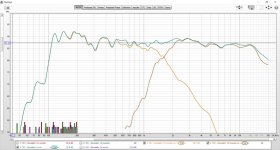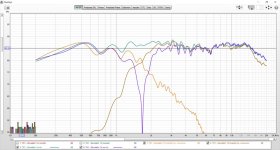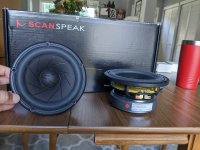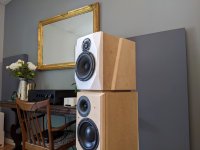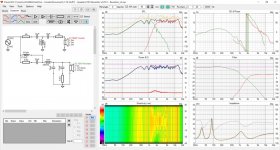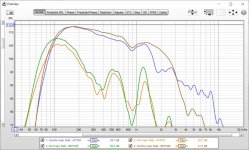Ok, just took a look at the Vituix files:
Did you measure both units with the exact same mic position? Asking as the summing of the signals look super ragged .... I guess this could be caused by difference in mic placement. Have the mic ca 1 m in front of the tweeter, and measure both woofer and tweeter from this position
Also the woofer measurement is that really correct? ... big dip at 4k and peak at 6k ...
I can see why you have chosen the very low Xover point. The woofer shows a nice 6 db baffle step from ca 600 Hz. You should incorporate a correction to help this, a coil and a resistor in parallel with each other and in series with the woofer.
It's good you have impedance correction on the woofer, makes the filtering much easier. But the values are not good. Before starting to make the filter, make the impedance flat towards high freq. 15 uF + 8 ohm seem to do the trick.
Do you use the optimizer to show the filtered target responce for each driver? Do the drivers first one by one making sure they follow a predicted roll off e.g. 2. order 2500 Hz
The combine and optimize
Did you measure both units with the exact same mic position? Asking as the summing of the signals look super ragged .... I guess this could be caused by difference in mic placement. Have the mic ca 1 m in front of the tweeter, and measure both woofer and tweeter from this position
Also the woofer measurement is that really correct? ... big dip at 4k and peak at 6k ...
I can see why you have chosen the very low Xover point. The woofer shows a nice 6 db baffle step from ca 600 Hz. You should incorporate a correction to help this, a coil and a resistor in parallel with each other and in series with the woofer.
It's good you have impedance correction on the woofer, makes the filtering much easier. But the values are not good. Before starting to make the filter, make the impedance flat towards high freq. 15 uF + 8 ohm seem to do the trick.
Do you use the optimizer to show the filtered target responce for each driver? Do the drivers first one by one making sure they follow a predicted roll off e.g. 2. order 2500 Hz
The combine and optimize
I agree, what did I expect? hahaha.Hi flipsnshyt
But looking at your impedance response it all seems fine and very much in line with the simulations. You have a resonance freq at ca 50 Hz, and I think this is more or less what you can expect from this driver. ...... and I was almost going to say; what did you expect? 😉 ...
I would now concentrate the effort on making the overall sound balance better = decrease output in mids and highs. If you are playing through a PC, you might have access to an equilizer, you could try playing with that first to find and measure something which you like. Then you can make a filter afterwards which implements this.
/Baldin
I'll consider changing the crossover up. I have been messing around with some EQ through the miniDSP and I keep coming to the same conclusion that I'm not sure it's worth putting more money into since I'm giving these away and honestly they sound pretty good. They just don't react very much to EQ in the low end. The highs may be a little to loud but they aren't harsh.
I'll be moving on to a 3 way with SB drivers. I already have the 9.5" Satori woofers and I'll move up in the lines for the mid this time.
Here are the near field measurements.
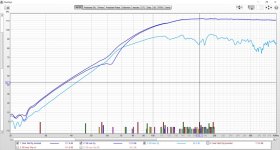
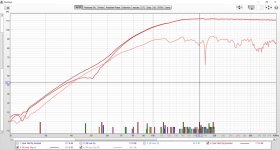
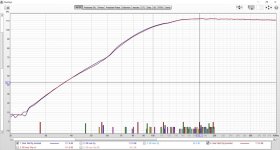
Fair enough 😉
The Satori 9,5" should be a bit better for bass 🙂 😉
For mid, go for either NBAC or Satori. I've been working on my new PC speakers (with sub) for some time. Active with DSP, using SB15NBAC30-4 and SB26ADC-C000-4 in a Visaton waveguide. Don't get much better I think.
I was actually using the Peerless DA25TX00-08 tweeter, but was a bit unfortunate to damage one, and having difficulty getting new ones at a decent price: http://www.sensibleaudio.dk/2022/05/22/the-difference-in-sound-of-two-excellent-dome-tweeters/
Fun "fact": to my knowledge Ravel Performa 3 uses: SB26ADC-C000-4, SB15NBAC30-8, 2x SB17NBAC35-4 (or -8)
I'm using a 7,5" Satori (paper) + SB29RDAC-C000-4 in a Monacor waveguide for my center speaker, also really good.
Going active, makes filtering and finetuning so much easier and so much better. There ae differences in sound and distortion, but nothing is as important as in room frequency response (and room acoustics).
The Satori 9,5" should be a bit better for bass 🙂 😉

For mid, go for either NBAC or Satori. I've been working on my new PC speakers (with sub) for some time. Active with DSP, using SB15NBAC30-4 and SB26ADC-C000-4 in a Visaton waveguide. Don't get much better I think.
I was actually using the Peerless DA25TX00-08 tweeter, but was a bit unfortunate to damage one, and having difficulty getting new ones at a decent price: http://www.sensibleaudio.dk/2022/05/22/the-difference-in-sound-of-two-excellent-dome-tweeters/
Fun "fact": to my knowledge Ravel Performa 3 uses: SB26ADC-C000-4, SB15NBAC30-8, 2x SB17NBAC35-4 (or -8)
I'm using a 7,5" Satori (paper) + SB29RDAC-C000-4 in a Monacor waveguide for my center speaker, also really good.
Going active, makes filtering and finetuning so much easier and so much better. There ae differences in sound and distortion, but nothing is as important as in room frequency response (and room acoustics).
Last edited:
I ignored everything I said about not spending any more and decided to give the ceramic woofers a shot. The simulations looked like the low end would get a boost and extend almost 10hz lower without any changes to the enclosure. All I had to do was sand the ID of the woofer cutout 2mm. They have definitely extended the low end and are now reacting to some low frequency EQ so I think I'm getting closer. I'm going to let them break in for a bit then re-do the xo. Initial shots look like the ceramic break up is pretty intense (supported by the datasheet too). The measurements below are without any changes to my original crossover.
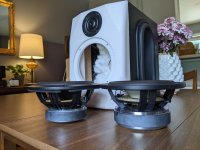

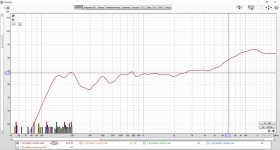
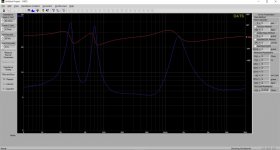




With those specific SB Acoustics drivers I wasn't able to get the sweet mid-range that the PFC woofer made and the bottom end that the Ceramic woofer provided.
I decided I was still interested in trying to make a small bookshelf that could get the best of both worlds and I still had the original enclosure I made for this project. I went with the ScanSpeak Revelator 15W-4531G00 and converted the from a passive radiator to ported.
This was the first time I've purchased a ScanSpeak driver and I had only heard the Revelators in Wilson Sabrinas in the store I used to work at. When you hear a $30,000 speaker you expect it to sound really good. I really didn't expect these to blow me away in my enclosures, but jeeeezzzz. No wonder Wilson and others use these. I have used some expensive-ish drivers in the past, but the Revelators have tricks that I've never heard before. I should have tried them a long time ago.
The bass that these make shocking in my opinion. The detail up and down the frequency range is unlike any build I've made in the past. I've always been able to achieve a sold center image, but these do a great job spreading the details laterally. The drivers can multi-task so much better than others I've used.
For the crossover, I used the leading elliptical looking filter for a second order baffle step filter. The baffle step and diffraction kind of stacked on top of each other, so I wanted a steeper filter. I'm not sure if that's a dumb solution, but it seems to have worked based on the measurement. Maybe there is a better sounding solution, idk.
I decided I was still interested in trying to make a small bookshelf that could get the best of both worlds and I still had the original enclosure I made for this project. I went with the ScanSpeak Revelator 15W-4531G00 and converted the from a passive radiator to ported.
This was the first time I've purchased a ScanSpeak driver and I had only heard the Revelators in Wilson Sabrinas in the store I used to work at. When you hear a $30,000 speaker you expect it to sound really good. I really didn't expect these to blow me away in my enclosures, but jeeeezzzz. No wonder Wilson and others use these. I have used some expensive-ish drivers in the past, but the Revelators have tricks that I've never heard before. I should have tried them a long time ago.
The bass that these make shocking in my opinion. The detail up and down the frequency range is unlike any build I've made in the past. I've always been able to achieve a sold center image, but these do a great job spreading the details laterally. The drivers can multi-task so much better than others I've used.
For the crossover, I used the leading elliptical looking filter for a second order baffle step filter. The baffle step and diffraction kind of stacked on top of each other, so I wanted a steeper filter. I'm not sure if that's a dumb solution, but it seems to have worked based on the measurement. Maybe there is a better sounding solution, idk.
Attachments
Last edited:
I took some measurements at the port to see what kind of resonances I had going.
The green trace was the original location of the port and the I found the amplitude of the resonances a bit offensive.
I did some searching to see what people have done about port resonances (assuming that's actually the issue I measured). I came across something that said the port location could affect things a lot. The original port location was 2.5" from the top of the enclosure and the height of the enclosure is 10.625". Some quick math said the longest standing wave would be very close to the 1200Hz resonance that I measured and 1/4 wavelength would be at almost exactly 2.5".
So I moved the port from the center of the enclosure 2.5" from the top -> to as close to the top corner as I could get it considering the cutout diameter. It ended up being 1.875" from the top. The orange trace was taken after the move. Seems like moving the port was pretty affective for being free.
What do you guys think? Was the improvement related to the port location or am I confused and somehow getting lucky?
The green trace was the original location of the port and the I found the amplitude of the resonances a bit offensive.
I did some searching to see what people have done about port resonances (assuming that's actually the issue I measured). I came across something that said the port location could affect things a lot. The original port location was 2.5" from the top of the enclosure and the height of the enclosure is 10.625". Some quick math said the longest standing wave would be very close to the 1200Hz resonance that I measured and 1/4 wavelength would be at almost exactly 2.5".
So I moved the port from the center of the enclosure 2.5" from the top -> to as close to the top corner as I could get it considering the cutout diameter. It ended up being 1.875" from the top. The orange trace was taken after the move. Seems like moving the port was pretty affective for being free.
What do you guys think? Was the improvement related to the port location or am I confused and somehow getting lucky?
